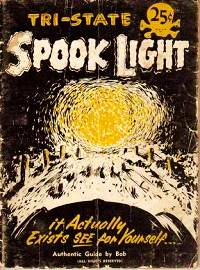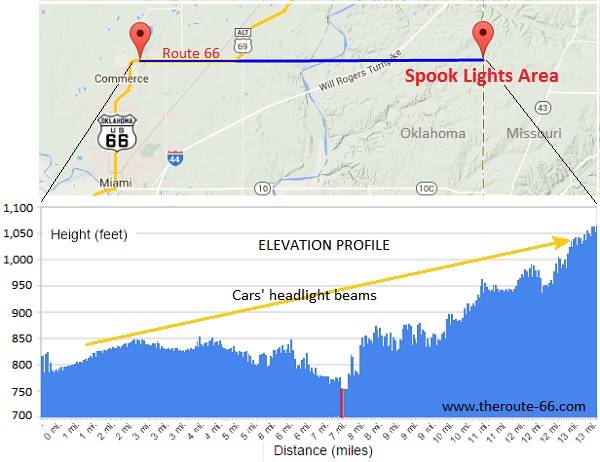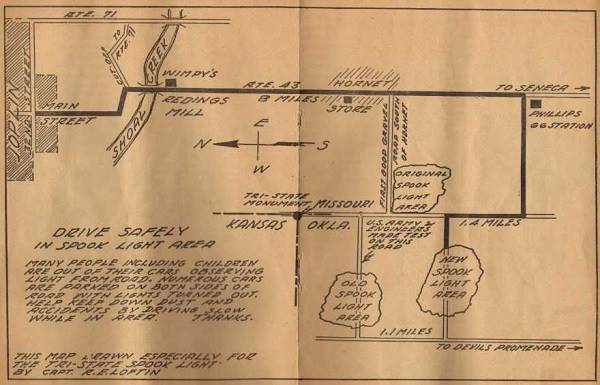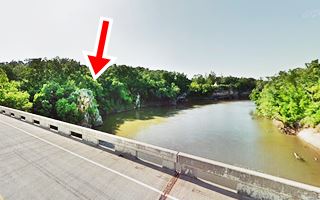Table of Contents
Index to this page:
- The strange "Spook Lights"
- What are the Spook Lights?
- Timeline of the mysterious lights
- Explanations for the Ghost Light phenomenon
- Route 66 and its role in the Spook Lights
- Hotels
The strange "Spook Lights"
In the area of Oklahoma that lies to the east of Route 66, between Baxter Springs, KS and Miami, OK, and also southwest of Joplin Missouri, strange sightings have been reported. They describe bobbing balls of light that glow with varying intensity and move about, change color and come and go without any seemingly rational explanation for them.
There are several websites that deal with the paranormal and UFOs ⁄ UAPs which provide information about the "Ghost Light" phenomenon. Some magazine articles and even books have been written about them. Below we will summarize the most relevant information on these very unusual lights (at the bottom of this web page you can check the sources for further reading).
Ghost Light, Spook Light, Hornet Lights...

1955. Booklet by Ret. Capt. Bob Loftin on the "ghostly lights"
Source
The phenomenon is known under different names:
- "Ghost Light"
- "Mysterious Light of the Ozarks"
- "Tri-State Spooklight"
- "Indian Light"
- "Spook Light"
- "Phantom Light"
- "Hornet Lights" (after the town of Hornet, Missouri)
What are the Spook Lights?
They are described as a glowing ball of light with varying intensity that grows bright and dim, bounces about as if it were a ball tossed about in the air. It disappears and fades. It vanishes when drivers attempt to approach it. The light can "dance through trees" or hop across fields.
The now gone Spooklight Museum
At one time a local named Garland "Spooky" Middleton built and ran a small museum, the Spooklight Museum.
It was located on the Missouri - Oklahoma state line and had a collection of photographs and newspaper clippings about the "lights".
After Middleton's death, the museum and store closed.
Timeline of the mysterious lights
The oldest reports are said to date back to the days of the infamous "Trail of Tears" in 1838-39, when a young Indian girl saw the light moving through the trees in this area.
First Reports 1800s
Trail of Tears
The Treaty of New Echota signed under the provisions of the Indian Removal Act of 1830, forced the Cherokee nation to hand over their territories in the east for new land in the "Indian Territories", what is now the state of Oklahoma. The migration was terrible and the uprooted natives lost more than they received. Thousands of Native Americans died on the trail.
The first written report was drafted in 1881 (or 1884, depending on the source). And, it is said that there were many sighting of balls of light near the village of Hornet in 1896.
It has been reported by people living in the area comprised by Quapaw, Commerce, Miami, Seneca, Hornet, Neosho and Joplin.
Tourist Attraction
In the movies
A short film, of the animate "Cars" series by Pixar ⁄ Disney, "Mater and the Ghostlight", was inspired by these unearthly lights.
The Light was a well-known phenomenon by the mid 1930s, perhaps due to a growing flow of traffic along Route 66, and it actually became a tourist attraction in the area during the 1950s, 60s and 70s. Later people seemed to lose interest in it.
Explanations for the Ghost Light phenomenon
Trying to explain how they for
Many theories have been put forth to explain the "Spook Light" phenomenon, from the superstitious to the scientific. Below we review some of them.
1. Ghost of a miner with his lantern
Unscientific
White men began to settle in the Indian territory in the 1870s, and one night some Indians attacked a cabin close to the Missouri - Oklahoma border, kidnapping a miner's wife and children while he was away, working at the mine.
He took his lantern and began searching for them, and he was never seen again. Today his spirit roams at night, still searching for his lost family.
2. Ghosts of an Indian Couple
Unscientific
A young Indian warrior fell in love with a girl of the Quapaw tribe, but the maiden's father, the tribe's Chief asked the young man for a very large payment for his daughter's hand. As he could not pay such an amount, the lovers eloped. However their escape was quickly discovered and the Chief sent a party to capture them. The couple knew the severe punishment that they would face if caught, so they took a terrible decision: they committed suicide by jumping off the rocky cliff on Spring River, which is now known as "Lovers' Leap" or "Devil's Promenade."
Their ghosts now haunt the region and are the source of the glowing light.
In his 1947 book on folklore of the Ozarks, Vance Randolph mentions the ghost of an Osage chief who was murdered in that area and another variant of the Indian couple: the Indian girl killed herself in the river after learning that her boyfriend died in battle (an interesting twist to the Lovers' Leap legend).
Devil's Promenade
The upper part of a geological formation known as Boone, is a thick body of hard gray cherty limestone that is exposed along the west bank of Spring River just below the Kansas - Oklahoma state line.
This rock shelf is known as "Devil's Promenade", and the rock it is made from (cherty limestone) is referred to as the "Lincolnville chert" or the "Quapaw chert"
The Devil's Promenade has a shelf several yards wide, located 25 feet above the water which extends along the whole face of the rock a distance of 600 feet.
It is the venue where, every July 4th the Indians hold the Quapaw Pow-Wow.
Below are the Scientific explanations.
3. Marsh Gas
Organic material in marshes and swamps can decompose and ferments under conditions where oxygen is not present (anaerobic digestion), and this produces methane gas. The gas is also known as "marsh gas", "swamp gas" (actually a biogas like that produced in the digestive tracts of most animals).
Biogas can accumulate and the fermentation process can also generate heat which in turn may cause the spontaneous combustion of the gas. Methane gas is the main component of natural gas, and its flame can vary in color from yellow to blue depending on the oxygen to gas ratio. These fires can smolder underground for long periods of time.
4. Piezoelectric activity
Piezoelectricity is electricity generated by stress forces in certain materials. When pressure is applied to a piezoelectric material, an electric charge is created.
Certain minerals, crystals, artificial ceramics and organic materials like bone or proteins are piezoelectric.
Tectonic strain can compress minerals and if those rocks contain piezoelectric substances like zinc oxide, lead titanate, quartz, silicon or arsenic, electric charges will be generated.
This electricity could heat the rocks and vaporize water and work its way to the surface to generate luminous phenomena.
Earthquakes and Volcanic eruptions which cause enormous tectonic pressure produce "Earthquake Lights". This actually happened in Missouri, when lights were seen glowing in the sky during the 1811-1812 earthquakes in New Madrid, MO.
5. Will-o'-the-wisp
A ghostly light seen at night, glimmering weakly in bogs and known also as "ignis fatuus" (Latin for foolish fire). Perhaps due to Marsh Gas or other natural chemiluminescent compounds such as phosphine mixed with air.
Bioluminescence can also explain it: fireflies or honey fungus. Reflection of moon light, etc.
6. St. Elmo's Fire
This is a weather phenomenon, in which glowing plasma is created by strong atmospheric electrical fields. These can be caused by tornados, thunderstorms and even by volcanic eruptions.
They are named after the patron saint of sailors (St. Elmo - also known as St. Erasmus or St. Erasmo) because the "St. Elmo's Lights or Fire" were frequently spotted on the masts of sailing ships during thunderstorms at sea.
The appear as glowing sheets of light and even as balls of light which can glow with bluish and violet hues, like neon lights.
7. Refracted Light
Like a mirage, the light from a distant artificial source finds its way to the "spook light" area.
Mr. Logan Smith, from Neosho, MO., was the first to suggest that the lights of cars driving east down Highway 66 produced the ghostly lights. A reporter from the Kansas City Star investigated the matter in 1936 (Route 66 was only ten years old at the time) and also pointed at US 66 automobiles as the source of the lights.
Some Army Engineers are said to have studied the lights in 1946, but did not manage to confirm that they were caused by lights from cars driving along a nearby road or highway.
In the early 1950s, Capt. "Bob" Loftin, Ret., detected that the Army Engineers had used the wrong road and he noticed that Highway 66 to the south of Quapaw had an east to west course which could be the cause of the ghost light.
He believed that as traffic fluctuated between one and 20 or 30 cars moving in the same direction, that could explain why the phantom light's intensity varied so much. And that tail lights could give it reddish hue too.
Spook Light, an explanation: headlight beams from Route 66

The fact that there are some hills between the ghost light sighting area and Route 66 is not a problem because the different density of the layers of air will bend the beams of light, refracting them over the hills and back down on the other side.
The image above shows how the beams of a car's headlights (blue line in the map) could shine from Route 66 to the "spook light" area. Also, the elevation profile shows the beams (yellow arrow) shining uphill: the sighting area is 225 ft. (68 m) higher than the Route 66 alignment north of Commerce, OK. The beams of light can reach it unimpeded by traveling 13 miles (21 km) across the night sky.
The option was studied in the 1960s by William Underwood from Carthage Missouri as part of his high school science project. He concluded that the lights were caused by cars driving along U.S. Route 66 west of Quapaw Oklahoma. Apparently he got a spectroscopic reading that proved that the light was from an incandescent source (i.e. a hot filament like those in a car's headlamp).
One of the objections to this theory is that the lights had shifted position in the near past, moving towards the south. How could this be explained? Actually it has not been explained until now; we have a theory that does explain it.
Refraction and Mirages
Place a pencil in a half-full glass of water and it will look bent. Watch the sun set on the horizon and you will see it distort, split into segments and stretch. Look at a twinkling star at night or the "water" on the surface of a hot highway. These are all caused by rays of light bending as they go through different layers of transparent media: water and air or hot and cool air.
The temperature, atmospheric pressure (and therefore the altitude of the observer) and humidity in the air will affect its density and its refractive properties and bend light with different angles, causing beams to split and wave in the air (like a twinkling star or like a mirage that trembles on the horizon on a highway).
Under certain conditions it can cause multiple images and even reflect light or create rainbow effects because each color refracts at a different angle!
Route 66 and its role in the Spook Lights
The following is the result of our own investigations and has not been published in any other source.
Shifting Location
The map reproduced below, was included in the "Tri-State Spook Light" booklet and was drawn by Capt. R. E. Loftin. It shows that the "areas" where Spook Light appears has moved over time.
Shifting location of the Spook Light is explained by a "shifting" Route 66 alignment

Over time, the lights have moved southwards. The locations of the sites where the lights can be seen are shown with orange markers in our Custom Map. further up, so has the east-west alignment of Route 66. This clearly points at some correlation between US 66 and Spook Lights.
The original dirt surfaced Ozark Trail road, which became the first (1926 - 1932) alignment of Route 66 (shown with the dark blue line in the map), ran along what is now E40 Rd. east of Quapaw before turning north along what is now S630Rd.
This was replaced by a new paved alignment (pale blue line) in the mid 1930s.
As you can see with the Black arrow, the headlights of cars driving along this old section would have gone straight eastwards and passed through the "old" areas where "spook light" was sighted.
The new alignment of Route 66 in the 1930s, south of Quapaw and north of Commerce is directly lined up with the "later" sites where "spook light" is seen (as shown with the "Red arrow").
Plan your Visit
Where to Stay
There are several hotels in Miami. Alternatively you can also lodge in the neighboring towns in Kansas, Missouri and Oklahoma:
> > Book your Miami Oklahoma
There are several hotels in the area close to this area:
On Route 66's Main alignment
Eastwards
Sponsored Content
>> Book your Hotel in Miami

Credits and Further Reading
Banner image: Hackberry General Store, Hackberry, AZ by Perla Eichenblat
Jarret Medin, Seeking the light for more than a century, the Hornet Spook Light has brought mystery to southwest Missouri, Oct. 2005, Rural Missouri Magazine.
Dale Kaczmarek, Joplin Spooklight Investigation, 2004, Ghost Research Society
An Introduction to Mirages by Andrew Young.
Vance Randolph, 1947, Ozark Magic and Folklore


